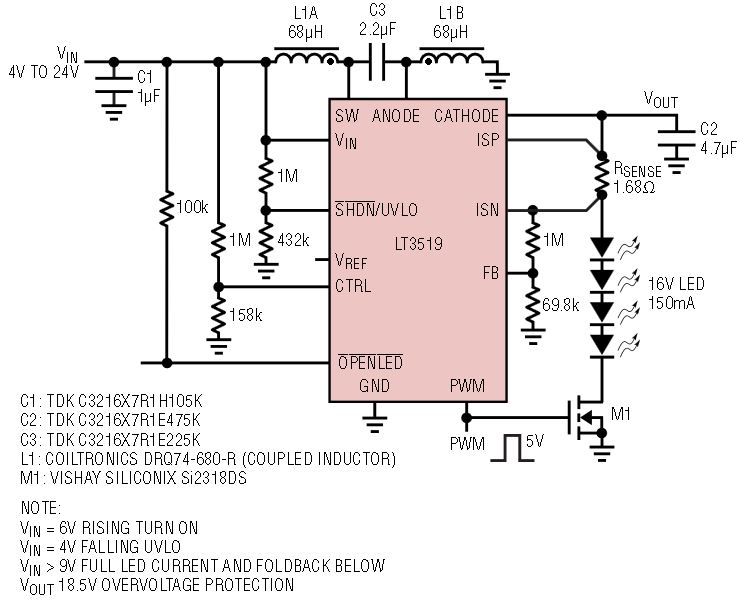4W LED Driver Includes Power Switch, Compensation Components and Schottky in 16-Pin MSOP
4W LED Driver Includes Power Switch, Compensation Components and Schottky in 16-Pin MSOP
2009年09月01日
Introduction
As the number of applications for medium power (1W–4W) LED strings grows, so does the need for compact, efficient, high performance LED drivers. The LT3519 LED driver satisfies the needs of a wide variety of applications, including LCD displays, automotive and avionic applications, architectural and industrial lighting, portable projection and scanners. It’s 16-pin MSOP package includes accurate LED current regulation, small size, high efficiency, PWM and analog dimming for brightness control and open circuit protection with fault detect.
Easy Layout: Integrated Power Switch, Compensation Components and Schottky
The 400kHz LT3519 LED driver features an integrated 750mA 45V peak power switch, integrated compensation components and an integrated low leakage Schottky diode, making designs simple and small. Despite this high level of integration, it can be used in a wide variety of topologies, including boost, SEPIC, buck mode or buck-boost mode. For maximum versatility, the Schottky diode anode (ANODE) and internal power switch emitter (SW) pins are separately pinned out, so a SEPIC coupling capacitor can be inserted between these two.
The internal compensation components are chosen to match the 2.2μF to 4.7μF output capacitors in all of the topologies mentioned above. The integrated compensation network combined with current mode control yields fast and stable transient response.
OPENLED detection and fault reporting are included. A simple resistor divider sets the overvoltage protection output voltage in case of an open LED string and a small pull-up resistor is all that is needed to assert the open collector OPENLED output pin during a fault.
4W Boost LED Driver
The simple boost LED driver in Figure 1 drives up to 38V of LEDs at 100mA from an automotive input voltage range. The 400kHz switching frequency is common for automotive, avionic and industrial solutions; it combines high efficiency, small inductor and capacitor size, and high PWM dimming capability while avoiding frequencies in the AM broadcast band. A small inductor with about 750mA saturation current rating, a few ceramic capacitors and several tiny resistors are all that are needed to complete the design. As shown in Figure 2, the tiny PWM dimming MOSFET can be used to provide over 1000:1 pwm dimming at 120Hz using the integrated LT3519 PWM dimming architecture and an extremely low leakage integrated Schottky diode.

Figure 1. A 4W boost LED driver with 89% efficiency at 12VIN.

Figure 2. Integrated PWM dimming yields 1000:1 dimming at 120Hz.
A 1000:1 dimming ratio at 120Hz is exceptionally high for a 400kHz switching regulator. It can be tempting to bump up the dimming ratio by choosing a higher frequency driver, since in general, higher switching frequency corresponds to higher PWM dimming ratios. In this case, avoiding the AM band means jumping to 2MHz, which in the end reduces the maximum duty cycle and the efficiency. The 400kHz switching frequency of the LT3519 does what 2MHz converters cannot do: it provides high duty cycle for operation down to 6VIN with 38VLED and as high as 89% efficiency at 12VIN. If PWM dimming is not needed, the MOSFET M1 can be removed and the analog dimming (CTRL) pin can be used to adjust the regulated LED current below 100mA for simple brightness control.
2.4W SEPIC LED Driver
When the LED string voltage is within the input rail voltage range, a SEPIC topology is called for. The SEPIC produces a high PWM dimming ratio and also gives short-circuit protection. The SEPIC in Figure 3 drives 16V LEDs at 150mA from a 4V to 24V input range. Since the anode of the integrated catch diode (ANODE) is made available at a pin independent of the npn power switch emitter (SW), the coupling capacitor is easily inserted between the two. The maximum voltage that the SW pin sees is a little above the input voltage plus the output voltage, so the 45V 750mA integrated power switch is a perfect match for these specifications.

Figure 3. A SEPIC LED driver with short-circuit protection.
Conclusion
The 400kHz LT3519 is a 4W LED driver that integrates a number of required components, including a 45V, 750mA power switch, a low leakage Schottky diode and compensation components. It also features PWM dimming, overvoltage protection and OPENLED fault detection, making it a small, simple, and efficient choice for automotive, avionic, industrial and other LED driver applications.
著者について
Keith Szolushaは、アナログ・デバイセズ(カリフォルニア州サンノゼ)のアプリケーション・ディレクタです。2000年からIPSパワー製品グループに所属しています。主に降圧/昇圧/昇降圧コンバータ、LEDやGaNに対応するコントローラ/ドライバなどの製品を担当。また、電源製品向けのEMIチャンバの管理も担っています。マサチューセッツ工科大学で1997年に電気工学の学士号、1998年に同修士号を取得。テクニカル・ライティングの集中コー...




















